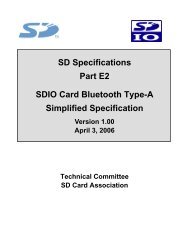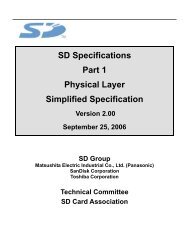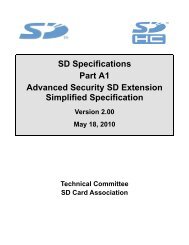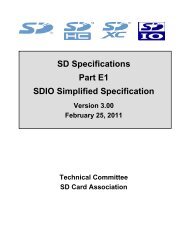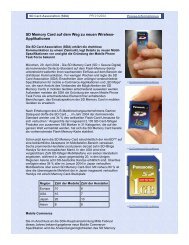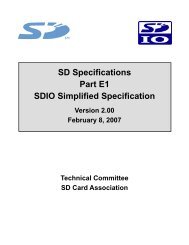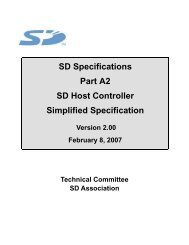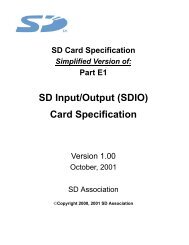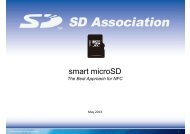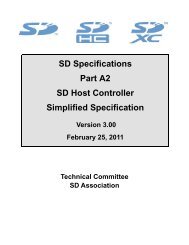SD Specifications Part 1 UHS-II Simplified Addendum - SD Association
SD Specifications Part 1 UHS-II Simplified Addendum - SD Association
SD Specifications Part 1 UHS-II Simplified Addendum - SD Association
Create successful ePaper yourself
Turn your PDF publications into a flip-book with our unique Google optimized e-Paper software.
<strong>UHS</strong>-<strong>II</strong> <strong>Simplified</strong> <strong>Addendum</strong> Version 1.01©Copyright 2010-2013 <strong>SD</strong> Card <strong>Association</strong>5.2.3 Header for <strong>UHS</strong>-<strong>II</strong> PacketFigure 5-2 illustrates header structure for <strong>UHS</strong>-<strong>II</strong> packet that is compliant to <strong>UHS</strong>-<strong>II</strong> <strong>Addendum</strong> Version1.00. First, Node ID whose range is from 0 to 15 denotes a value to identify the individual Hosts andDevices. Node ID = 0 is set aside for Host. For Devices, number 15 is set as the initial value for Node IDafter I/F power cycle or FULL_RESET, and one of numbers from 1 to 15 is assigned to each Device byEnumeration process described in Section 0. Note that Node ID of Boot Device is temporarily assignedfor Boot Code Loading at first, then one of numbers from 1 to 15 is assigned by Enumeration.Considering future extension, header format is allowed to be changed linked to LINK/TRAN MajorRevision in CFG_REG (refer to Table 6-9).BitByte07 6 5 4 3 2 1 0NP TYP (Packet Type)DID (Destination ID)1 SID (Source ID)RsvdTID (Transaction ID)Figure 5-2 : Header Format<strong>UHS</strong>-<strong>II</strong> Packet Header shall be composed of the following fields; NP (Native Packet): Indicator whether the packet follows native protocol or not 0: not native protocol (application specific protocol) 1: native protocol NP field in MSG shall be set to '1'. (MSG packet transaction is defined on native protocol.) TYP[2:0] (Packet Type): Packet type described in Table 5-3. DID[3:0] (Destination ID): Node ID of destination Device or Host. SID[3:0] (Source ID): Node ID of source Device or Host. TID[2:0] (Transaction ID): Identification number of outstanding transactions The TID field is defined in order to manage outstanding transactions for multiplecommand execution. (Details of multiple command execution will be defined in the futurespecification.) Rsvd (Reserved): Reserved bits. Initiator shall set them to '0', and receiver shall ignore them.TYP [2:0] Packet Type Description Note000b CCMD Control Command packet TLP001b DCMD Data Command packet TLP010b RES Response packet TLP011b DATA Data payload packet TLP111b MSG Message packet Handled in LINKOthers Reserved Reserved --Table 5-3 : Packet Type Encodings and DescriptionsDID and SID are used as routing information. If SID = DID, the packet is handled as broadcast. For<strong>UHS</strong>-<strong>II</strong> <strong>Addendum</strong> Version 1.00, broadcast packet is applicable only for CCMD. Details of broadcastCCMD are described in Section 6.2.2.3.Basically, Host or Device processes a packet with the same DID as its own Node ID. In case ofreceiving a packet with different DID from own Node ID, Host or Device does not process it exceptbroadcast packet and bypasses it to the next Host or Device on the bus. If Host or Device receivesbroadcast packet (SID = DID), it shall process even when DID is not equal to its own Node ID, andtransmit to the next Host or Device.34



